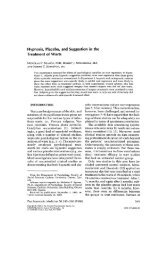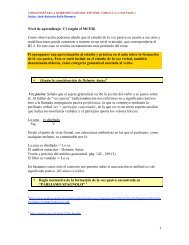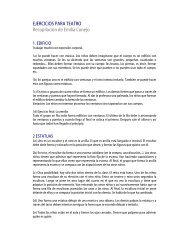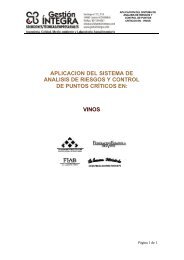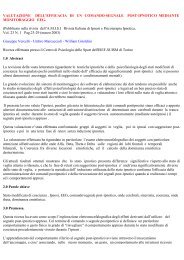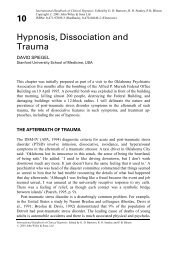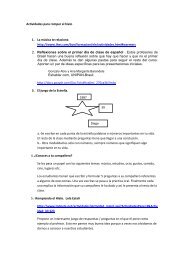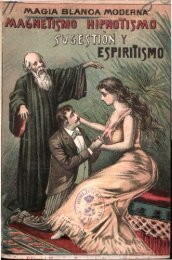Hypnosis and the Law: Examining the Stereotypes
Hypnosis and the Law: Examining the Stereotypes
Hypnosis and the Law: Examining the Stereotypes
Create successful ePaper yourself
Turn your PDF publications into a flip-book with our unique Google optimized e-Paper software.
Wagstaff / HYPNOSIS AND THE LAW 1293<br />
Rowl<strong>and</strong>, L. W. (1939). Will hypnotized persons try to harm <strong>the</strong>mselves or o<strong>the</strong>rs? Journal of Abnormal <strong>and</strong> Social<br />
Psychology, 34, 114-117.<br />
S<strong>and</strong>ers, G. S., & Simmons, W. L. (1983). Use of hypnosis to enhance eyewitness accuracy: Does it work? Journal of Applied<br />
Psychology, 68, 70-77.<br />
Scoboria, A., Mazzoni, G., Kirsch, I., & Milling, L. S. (2002). Immediate <strong>and</strong> persisting effects of misleading questions <strong>and</strong><br />
hypnosis on memory reports. Journal of Experimental Psychology: Applied, 8, 26-32.<br />
Sheehan, P. W., Green, V., & Truesdale, P. (1992). Influence of rapport on hypnotically induced pseudomemory. Journal of<br />
Abnormal Psychology, 101, 690-700.<br />
Sheehan, P. W., & Perry, C. W. (1976). Methodologies of hypnosis: A critical appraisal of contemporary paradigms of<br />
hypnosis. Hillsdale, NJ: <strong>Law</strong>rence Erlbaum.<br />
Sheehan, P. W., & Statham, D. (1988). Associations between lying <strong>and</strong> hypnosis: An empirical analysis. British Journal of<br />
Experimental <strong>and</strong> Clinical <strong>Hypnosis</strong>, 5, 87-94.<br />
Sheehan, P. W., & Tilden, J. (1983). Effects of suggestibility <strong>and</strong> hypnosis on accurate <strong>and</strong> distorted retrieval from memory.<br />
Journal of Experimental Psychology: Learning, Memory, <strong>and</strong> Cognition, 9, 283-293.<br />
Sheridan, C. L., & King, R. G. (1972). Obedience to authority with an au<strong>the</strong>ntic victim. Proceedings, 80th Annual Convention<br />
APA, 45, 165-166.<br />
Silva, C. E., & Kirsch, I. (1987). Breaching hypnotic amnesia by manipulating expectancy. Journal of Abnormal Psychology,<br />
96, 325-329.<br />
Smith, M. C. (1983). Hypnotic memory enhancement of witnesses: Does it work? Psychological Bulletin, 94, 387-407.<br />
Spanos, N. P. (1986). Hypnotic behavior: A social psychological interpretation of amnesia, analgesia, <strong>and</strong> “trance logic.”<br />
Behavioral <strong>and</strong> Brain Sciences, 9, 449-502.<br />
Spanos, N. P. (1991). A sociocognitive approach to hypnosis. In S. J. Lynn & J. W. Rhue (Eds.), Theories of hypnosis: Current<br />
models <strong>and</strong> perspectives (pp. 324-361). New York: Guilford.<br />
Spanos, N. P. (1992). Compliance <strong>and</strong> reinterpretation in hypnotic responding. Contemporary <strong>Hypnosis</strong>, 9, 7-14.<br />
Spanos, N. P., & Chaves, J. F. (Eds.). (1989). <strong>Hypnosis</strong>: The cognitive behavioral perspective. Buffalo, NY: Prome<strong>the</strong>us.<br />
Spanos, N. P., Cobb, P. C., & Gorassini, D. R. (1985). Failing to resist test suggestions: A strategy for self-presenting as<br />
deeply hypnotized. Psychiatry, 48, 282-292.<br />
Spanos, N. P., Gwynn, M. I., Comer, S. L., Baltruweit, W. J., & de Groh, M. (1989). Are hypnotically induced pseudomemories<br />
resistant to cross-examination? <strong>Law</strong> <strong>and</strong> Human Behavior, 13, 271-289.<br />
Spanos, N. P., Quigley, C. A., Gwynn, M. I., Glatt, R. L., & Perlini, A. H. (1991). Hypnotic interrogation, pretrial preparation,<br />
<strong>and</strong> witness testimony during direct <strong>and</strong> indirect cross-examination. <strong>Law</strong> <strong>and</strong> Human Behavior, 15, 639-653.<br />
Steblay, N. M., & Bothwell, R. K. (1994). Evidence for hypnotically refreshed testimony. <strong>Law</strong> <strong>and</strong> Human Behavior,<br />
18, 635-651.<br />
Troyer, A. K., Moscovitch, M., & Winocur, G. (1997). Clustering <strong>and</strong> switching as two components of verbal fluency:<br />
Evidence from younger <strong>and</strong> older healthy adults. Neuropsychology, 11, 138-146.<br />
Udolf, R. (1983). Forensic hypnosis: Psychological <strong>and</strong> legal aspects. Lexington, MA: Lexington Books.<br />
Vingoe, F. J. (1995). Beliefs of British law <strong>and</strong> medical students compared to an expert criterion group on forensic hypnosis.<br />
Contemporary <strong>Hypnosis</strong>, 12, 173-187.<br />
Wagstaff, G. F. (1981). <strong>Hypnosis</strong>, compliance, <strong>and</strong> belief. Brighton, UK: Harvester.<br />
Wagstaff, G. F. (1982a). Helping a witness remember—A project in forensic psychology. Police Research Bulletin, 38, 56-58.<br />
Wagstaff, G. F. (1982b). <strong>Hypnosis</strong> <strong>and</strong> witness recall: A discussion paper. Journal of <strong>the</strong> Royal Society of Medicine,<br />
75, 793-797.<br />
Wagstaff, G. F. (1984). The enhancement of witness memory by hypnosis: A review <strong>and</strong> methodological critique of <strong>the</strong> experimental<br />
literature. British Journal of Experimental <strong>and</strong> Clinical <strong>Hypnosis</strong>, 2, 3-12.<br />
Wagstaff, G. F. (1989). Forensic aspects of hypnosis. In N. P. Spanos & J. F. Chaves (Eds.), <strong>Hypnosis</strong>: The cognitive behavioral<br />
perspective (pp. 340-357). Buffalo, NY: Prome<strong>the</strong>us.<br />
Wagstaff, G. F. (1991). Compliance, belief <strong>and</strong> semantics in hypnosis: A nonstate, sociocognitive perspective. In S. J. Lynn<br />
& J. W. Rhue (Eds.), Theories of hypnosis: Current models <strong>and</strong> perspectives (pp. 362-396). New York: Guilford.<br />
Wagstaff, G. F. (1998). The semantics <strong>and</strong> physiology of hypnosis as an altered state. Contemporary <strong>Hypnosis</strong>, 15, 149-164.<br />
Wagstaff, G. F. (1999a). Forensic hypnosis. In I. Kirsch, A. Capafons, E. Cardena-Buela, & S. Amigo (Eds.), Clinical<br />
hypnosis <strong>and</strong> self-regulation <strong>the</strong>rapy: A cognitive-behavioral perspective (pp. 277-310). Washington, DC: American<br />
Psychological Association.<br />
Wagstaff, G. F. (1999b). Hypnotically elicited testimony. In A. Heaton Armstrong, E. Shepherd, & D. Wolchover (Eds.),<br />
Analysing witness testimony (pp. 277-310). London: Blackstone.<br />
Wagstaff, G. F. (2000). On <strong>the</strong> physiological redefinition of hypnosis: A reply to Gruzelier. Contemporary <strong>Hypnosis</strong>,<br />
17, 154-162.<br />
Wagstaff, G. F. (2004). High hypnotizability in a sociocognitive framework. In M. Heap, D. Oakley, & R. Brown (Eds.), The<br />
highly hypnotisable person (pp. 85-114). London: Brunner-Routledge.<br />
Wagstaff, G. F., Brunas-Wagstaff, J., Cole, J., & Wheatcroft, J. (2004). New directions in forensic hypnosis: Facilitating<br />
memory with focused meditation. Contemporary <strong>Hypnosis</strong>, 21, 14-27.<br />
Downloaded from<br />
http://cjb.sagepub.com at SAGE Publications on October 31, 2008




